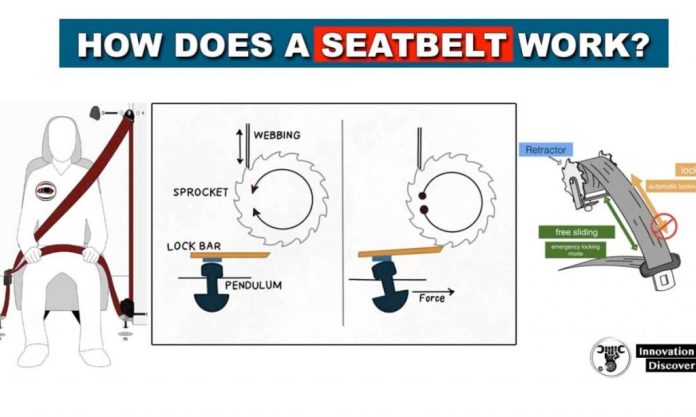A seat belt, also known as a safety belt, is a vehicle safety device designed to secure the occupant of a vehicle against harmful movement that may result during a collision or a sudden stop. Here is a simplified overview of how seat belts work:
PC: rlsdhamal
Components:
- Webbing: The belt material, usually made from a strong, woven fabric, capable of withstanding high tension and impacts.
- Retractor: A mechanism usually housed in the pillar or side of the seat, responsible for winding and unwinding the webbing.
- Buckle A device that fastens the seat belt and can be easily released.
- Tensioner: A device that tightens the seat belt in the event of a collision, reducing the occupant’s forward movement.
- Pretensioner: A mechanism that preloads the seat belt to remove slack in the event of a collision.
- Anchor Points: Secure mounting points for the seat belt system.
Functionality:
- Normal Use:
- The user pulls the webbing across their body and clicks it into the buckle, securing them in their seat.
- The retractor allows free movement but keeps the webbing snug.
- In normal driving conditions, the seat belt allows a comfortable range of movement while keeping the occupant secure.
- Locking Mechanism:
- Most retractors feature a locking mechanism activated by rapid deceleration or acceleration, such as in a collision or sudden stop.
- When the vehicle decelerates or accelerates abruptly, an inertia reel or other mechanism in the retractor locks, preventing more webbing from being pulled out, and securing the occupant in place.
- During a Collision:
- The pretensioner tightens the seat belt to remove slack, ensuring the occupant is firmly in their seat.
- The tensioner may activate to further tighten the belt.
- The locked belt spreads the force of the collision across the stronger parts of the occupant’s body (pelvis and ribcage), reducing the risk of injury.
- Some seat belts have load limiters that allow a bit of controlled webbing release under extreme loads, reducing the risk of seat belt-inflicted injuries.
- Post-Collision:
- After a collision, the seat belt may need inspection or replacement, especially the pretensioner, which is usually a single-use mechanism.

PC: vieiraimoveisrp
Supplementary Systems:
Seat belts are part of a comprehensive safety system and often work in conjunction with airbags, crumple zones, and other safety features to minimize injury during accidents. The combination of seat belts and airbags is especially effective, as seat belts position the occupant correctly and prevent ejection, allowing airbags to cushion the impact effectively.







